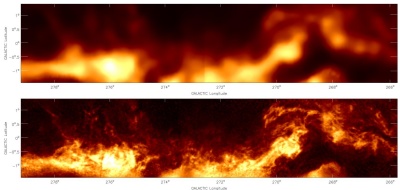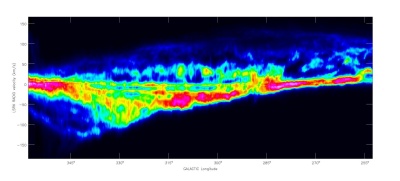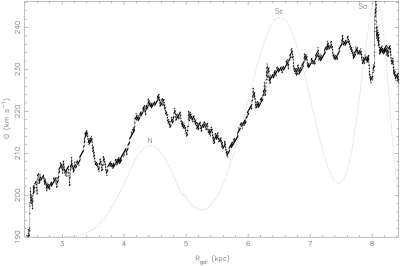The Southern Galactic Plane Survey
|
N. McClure-Griffiths (ATNF); J. Dickey (University of Minnesota, USA); A. Green (University of Sydney); B. Gaensler (Harvard University, USA) The Milky Way provides the closest laboratory for studying the physics of the interstellar medium (ISM). Despite some 50 years of studies with radio telescopes, our knowledge of the dynamics and thermodynamics of the atomic phase of the ISM is remarkably limited. However, for the past five years the ATNF has been involved in a large-scale survey of the ISM in the Southern Milky Way. This project, the Southern Galactic Plane Survey (SGPS), aims to image the 21-cm continuum emission and atomic hydrogen spectral line in a region of 335 square degrees in the plane of the Milky Way. The first part of the survey, SGPS I, covered an area of 210 square degrees centred on the Galactic midplane (Galactic latitudes 1 to +1 degrees), spanning Galactic longitudes from 253 to 358 degrees. In 2002 we began a second phase, SGPS II, which covers a 100 square-degree region around the Galactic Centre and extends along the Galactic midplane to longitude +20 degrees. The SGPS II is in progress, with completion anticipated in mid-2004. The SGPS constitutes more than an order of magnitude improvement in both angular resolution and sensitivity over previous surveys of this region. Additionally, the combination of high-resolution data from the Compact Array and short spacing information from the Parkes radio telescope provides a dataset that is sensitive to all angular scales from two arcminutes to several degrees, as illustrated in Figure 1. The general goals of the survey are to understand the structure, dynamics, and thermal distribution of the neutral hydrogen component of the ISM. We also have full polarisation information in the continuum that we are using to study the magnetic field structure of the Milky Way and the magnetoionic medium. The SGPS data has been combined with two surveys of the northern hemisphere Galactic plane made with telescopes in Canada, the USA, and Germany to form the International Galactic Plane Survey. The ultimate goal of this collaboration is to construct an atlas of the HI in the entire Galactic plane with an angular resolution of one arcminute, a spectral resolution of one kilometre per second and a sensitivity limit of one Kelvin. The SGPS is producing many new and exciting results. The work includes studies of HI shells, bubbles and chimneys (including the one on the cover of this report), which are some of the largest objects in the ISM. These objects, which are believed to be formed by the combined effects of stellar winds and supernovae, can break out of the Galactic plane and expel hot gas from the disk into the halo. The chimney shown on the cover, GSH 277+00+36, was discovered in the SGPS I; it is more than 600 parsecs in diameter and extends over a kiloparsec above and below the Galactic plane. Along the walls of this shell we have detected gas instability structures on scales of only a few parsecs. It is through these instabilities that gas returns to the cool phase and these may account for much of the small scale structure in the ISM. Using data from the entire SGPS I region we have created a new longitude-velocity diagram of HI emission, shown in Figure 2. We combine almost 10,000 spectra for this high-resolution image of HI in the plane. These data allow us to trace spiral features out to Galactic radius 30 kiloparsecs. There are a number of interesting features in this image. At large, positive velocities ( From the SGPS data we have measured the rotation curve of the inner Galaxy, shown in Figure 3. This is the most densely sampled HI rotation curve ever produced; it shows a number of new results. In particular we see strong departures from smooth circular rotation associated with the spiral arms, which are marked with dotted lines. According to spiral density wave theory we expect that gas approaching a spiral arm from the inner Galaxy side should show a decrease in circular velocity before the arm and then an increase as the gas passes through the arm. This is almost exactly what we see in the Milky Way. |
|



